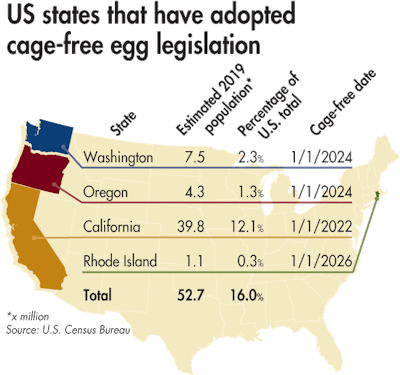
Haven't the activists already won the battle over how U.S. hens will be housed? After all, just about every major retail and foodservice outlet and major food processors have pledged to only purchase cage-free eggs and egg products by some future date. But most U.S. consumers are still purchasing more economical cage-produced eggs at retail.
Prior to the campaign to convince major egg buyers to make future cage-free egg purchase pledges, activists were able to get legislation passed in several states which addressed hen housing in a less-than-uniform manner. Washington and Oregon enacted standards that didn’t mandate cage-free but weren’t typical industry cage housing; they now have both passed legislation mandating that only cage-free eggs be sold in these states by the end of 2023.
Michigan’s legislature passed a bill mandating cage-free housing in December 2018, but it was vetoed by the governor in January. This legislation was to replace a law that mandates hens be given 144 square inches per bird in any type of enclosure by April 1, 2020. Expect the industry and activists to make another push for cage-free legislation in Michigan. Massachusetts has a law that mandates 1.5 square feet per hen, but not the type of enclosure required.
The four states that have laws mandating cage-free housing for hens have estimated 2019 populations of 55.3 million people, or 16% of the U.S. total. Adding in the populations of Michigan and Massachusetts would mean 21.1% of the total U.S. population would live in cage-free states.
U.S. consumers are voting with their wallets for less expensive eggs from cage-housed hens. Activists will continue to push for legislation mandating cage-free egg sales, because they know the type of eggs consumers will buy if given the choice.

















